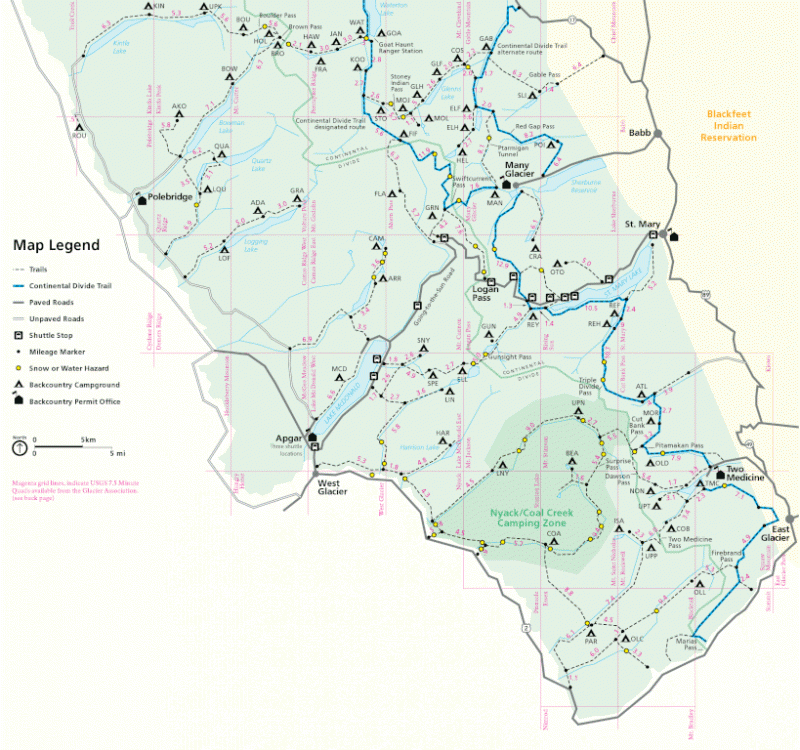
Map of Glacier National Park. The park is just over a million acres. Along with the Waterton Lakes National Park across the Canadian border it was designated as the first International Peace Park in 1935
Map of Glacier National Park. The park is just over a million acres. Along with the Waterton Lakes National Park across the Canadian border it was designated as the first International Peace Park in 1935
Unknown cartographer. Click here to view Wikimedia source.
 This work is licensed under a Creative Commons Public Domain Mark 1.0 License.
This work is licensed under a Creative Commons Public Domain Mark 1.0 License.
Glacier National Park (GNP), located in northwest Montana, US, was signed into existence on 11 May 1910 by then President William Howard Taft. Conservationist George Bird Grinnell was instrumental in lobbying for the park’s creation and negotiated the sale with the Blackfeet Indians. As an editor of the outdoor magazine Field and Stream, Grinnell learned about the region from writer James Willard Schultz and made his first visit there in 1885. Enticed and amazed by the glaciers of the area, the high Rocky Mountain alpine terrain, and the flora and fauna that thrived here, Grinnell advocated for the creation of the park, nicknaming it the “Crown of the Continent.”
Grinnell recognized glaciers as a geological wonder. As historian Gerald Diettert records in his 1992 book, Grinnell called the glaciers the “jewels” in the crown. Setting aside land to enjoy the glaciers seemed like a logical means to conserve the landscapes and ecosystems that they supported. Yet today, just about a hundred years from when the park was founded, the glaciers that form GNP’s snow-capped crown are close to extinction.
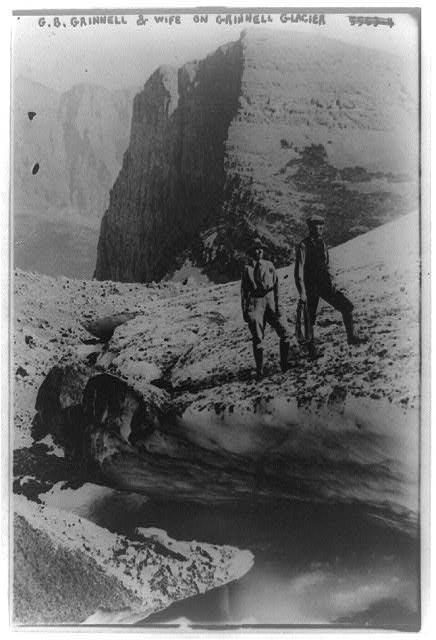
George Bird Grinnell and his wife on Grinnell Glacier, 14 March 1925
George Bird Grinnell and his wife on Grinnell Glacier, 14 March 1925
Unknown photographer. Courtesy of Library of Congress, Prints & Photographs Division, LC-USZ62-93186 (b&w film copy neg.). Click here to view source.
 This work is licensed under a Creative Commons Public Domain Mark 1.0 License.
This work is licensed under a Creative Commons Public Domain Mark 1.0 License.
At the time of the park’s establishment, a survey by geologist Bailey Willis suggested a lack of mining and agricultural prospects, which helped with Grinnell’s conservation efforts. However, like all parks in the developing US National Park Service system, the GNP’s conservation strategies have evolved over the years. In the early days, the park’s mandate focused more on tourism than on science. By the mid-1930s, there were more concerted scientific studies. Most recently, in 2012, the National Park Service (NPS) instituted a climate change action plan and response, which includes “repeat photography” as historical documentation of glaciers over time.
Historical photographs of glaciers began to be systematically used in the United States Geological Survey’s (USGS) collaboration with GNP in 1997. They provide a visual representation of glacier retreat. When combined with other types of geological information, such as USGS mapping and fieldwork, they help pinpoint the changing park landscape.
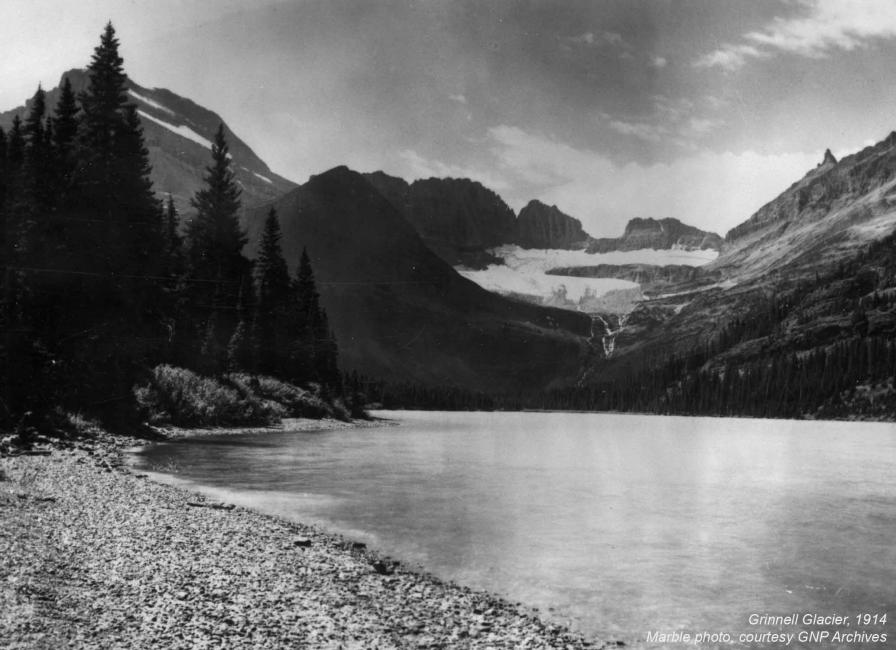
Grinnell Glacier from the shore of Lake Josephine in 1914.
Photograph by Marble Photo. Courtesy of the Glacier National Park Archives. Click here to view source.

Grinnell Glacier from the shore of Lake Josephine in 1938.
Photograph by T. J. Hileman. Courtesy of the Glacier National Park Archives. Click here to view source.
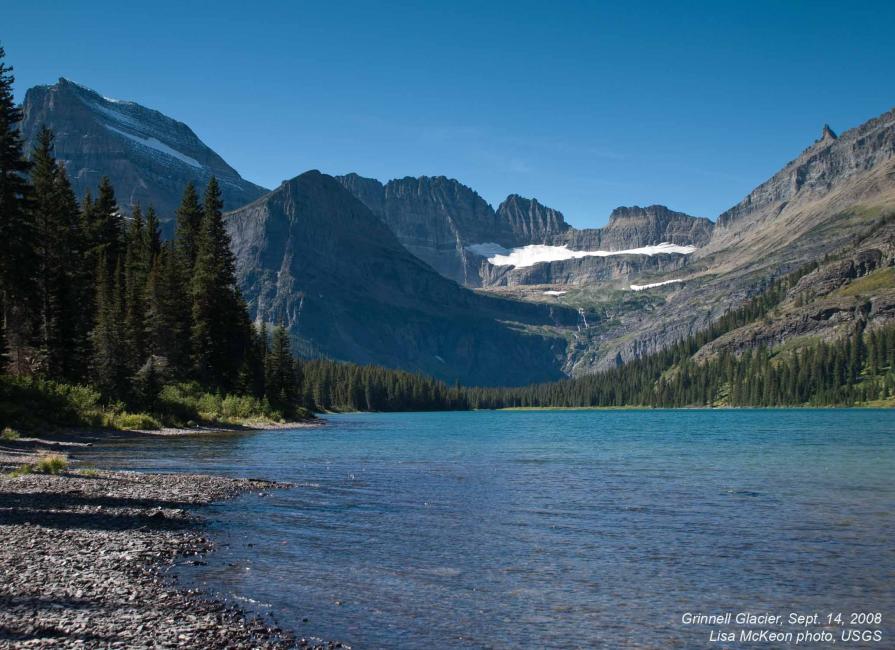
Grinnell Glacier from the shore of Lake Josephine in 2008.
Photograph by Lisa McKeon. Courtesy of USGS. Click here to view source.




Visually documenting Grinnell glacier as part of the repeat photography project in 2010
Visually documenting Grinnell glacier as part of the repeat photography project in 2010
Photograph by Lisa McKeon. Courtesy of USGS. Click here to view source.
 This work is licensed under a Creative Commons Public Domain Mark 1.0 License.
This work is licensed under a Creative Commons Public Domain Mark 1.0 License.
Geological records suggest that 150 glaciers existed in 1850. Today, the USGS reports that only 25 glaciers are currently recognized as “active”—that is, big enough (0.1 km2 or approximately 25 acres) to showcase the classic dynamics of movement we associate with glaciers.
It is important to note that glaciologists expected to see the park’s glaciers retreat from their 1850 extent. In fact, early investigations showed that glaciers had retreated from their maximum extent even at the time of the park’s establishment. This finding made scientific sense since geological records mark 1850 as the end of the Little Ice Age, a period of global cooling that began in the 1400s in North America, and had favored the growth of the glaciers.
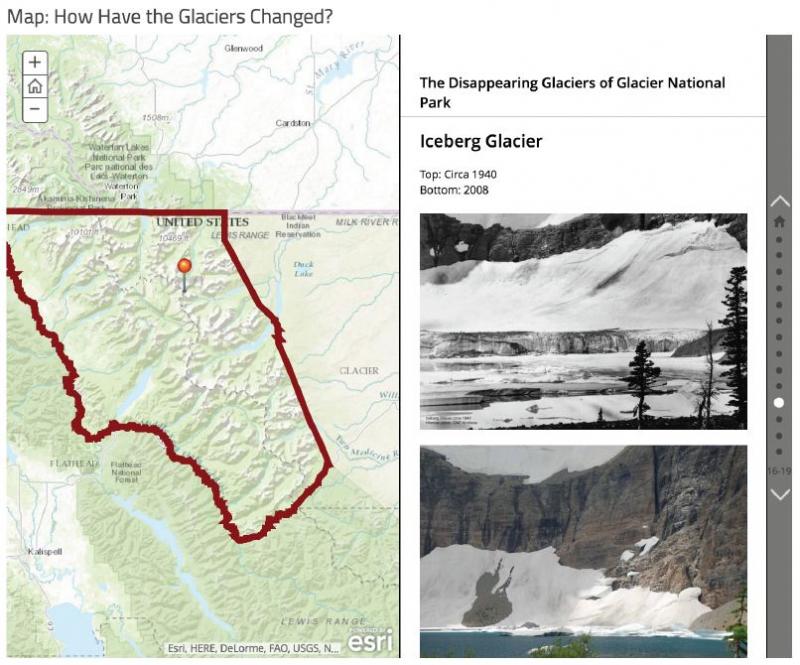
A screenshot from an environmental studies digital project conducted by the authors that showcases GNP’s “repeat photography” in a visually interactive way. Click here to visit the webpage “The Disappearing Glaciers of Glacier National Park.”
A screenshot from an environmental studies digital project conducted by the authors that showcases GNP’s “repeat photography” in a visually interactive way. Click here to visit the webpage “The Disappearing Glaciers of Glacier National Park.”
© Dori Gorczyca
This work is used by permission of the copyright holder.
However, what is alarming to geologists and park managers working on the historical, scientific, and recreational value of the park’s glaciers is the recent rapid rate of retreat. Climate model simulations reported by geologists Myrna Hall and Daniel Fagre in 2003 suggest that by 2030 GNP might be devoid of glaciers. USGS observations of actual rates of glacial retreat suggest this reality might come sooner than 2030.
The loss of glaciers has a cascade effect on the entire region, from water supply concerns to the struggle by species to adapt or perish with the changing landscape and climate conditions. While global temperature trajectories do not bode well for the park’s glaciers, interdisciplinary studies that combine visual history with science give the reality of climate change a “face.” Like the writings of GNP’s early conservationists—Schutz, Grinnell, and Wallis—these images can evoke environmental concern, and in this case, fuel legislative action to curb anthropogenic climate change.
How to cite
Gorczyca, Dori, Salma Monani, and Sarah Principato. “The Melting ‘Crown of the Continent’: Visual History of Glacier National Park.” Environment & Society Portal, Arcadia (Summer 2018), no. 20. Rachel Carson Center for Environment and Society. doi.org/10.5282/rcc/8315.
ISSN 2199-3408
Environment & Society Portal, Arcadia
 This work is licensed under a Creative Commons Attribution 4.0 International License.
This work is licensed under a Creative Commons Attribution 4.0 International License.
2018 Dori Gorczyca, Salma Monani, and Sarah Principato
This refers only to the text and does not include any image rights.
Please click on an image to view its individual rights status.
- DeSanto, Jerry. “Foundation for a Park: Explorer and Geologist Bailey Willis in the Area of Glacier National Park.” Forest & Conservation History 39, no. 3 (July 1995): 130–37.
- Diettert, Gerald A. Grinnell’s Glacier: George Bird Grinnell and Glacier National Park. Missoula, MO: Mountain Press, 1992.
- Fagre, Daniel, and Lisa McKeon. “Documenting Disappearing Glaciers.” In Repeat Photography: Methods and Applications in the Natural Sciences, edited by Robert Webb, Diane Boyer, and Raymond Turner, 77–88. Washington, DC: Island Press, 2010.
- Hall, Myrna H. P. and Daniel B. Fagre. “Modeled climate-induced glacial change in Glacier National Park, 1850-2100.” Bioscience 53, no. 2 (2003): 131–40.
- Harper, Andrew C. “Conceiving Nature: The Creation of Montana’s Glacier National Park.” Montana: The Magazine of Western History 60 (2010): 3–24.
- Key, C. H., D. Fagre, and R. Menicke. “Glacier Retreat in Glacier National Park” in Satellite Image Atlas of Glaciers of the World, edited by R. S. Williams Jr. and J. G. Ferrigno, J365–J376. Washington: USGS Professional Paper 1386J, 2002.
- Monani, Salma, Sarah Principato, Dori Gorczyca, and Elizabeth Cooper. "Loving Glacier National Park Online." In Case Studies in Climate Change Communication, edited by W. Leal Filho et al., 63–83. Vol. 3 of Handbook of Climate Change Communication. Cham: Springer International Publishing, 2018.










